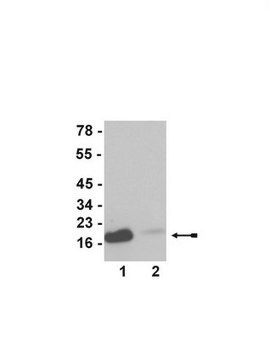일반 설명
We are committed to bringing you greener alternative products, which adhere to one or more of The 12 Principles of Green Chemistry.This antibody is Preservative-free, produced without the harm or sacrifice of animals and exceptionally stable to allow for ambient shipping and storage if needed and thus aligns with "Waste Prevention", "Designing Safer Chemicals" and "Design for Energy Efficiency".
Click here for more information.
ZooMAb antibodies represent an entirely new generation of recombinant monoclonal antibodies.
Each ZooMAb antibody is manufactured using our proprietary recombinant expression system, purified to homogeneity, and precisely dispensed to produce robust and highly reproducible lot-to-lot consistency. Only top-performing clones are released for use by researchers. Each antibody is validated for high specificity and affinity across multiple applications, including its most commonly used application. ZooMAb antibodies are reliably available and ready to ship when you need them.
Learn more about ZooMAb here.특이성
Clone MC315 is a ZooMAb rabbit recombinant monoclonal antibody that specifically detects Histone H3 trimethylated on Lysine 4.
면역원
BSA-conjugated linear peptide corresponding to an amino acid sequence containing (RTK4me3Q) (trimethylated lysine 4) from human Histone H3.
애플리케이션
Anti-trimethyl-Histone H3 (Lys4), clone MC315 ZooMAb, Cat. No. ZRB04791, is a highly specific rabbit recombinant monoclonal antibody that targets Histone H3 trimethylatled on lysine 4 and has been tested for use in Immunocytochemistry, Immunohistochemistry, Peptide Inhibition Assay, & Western Blot.
Immunohistochemistry (Paraffin) Analysis: A 1:100 dilution from a representative lot detected trimethyl-Histone H3 (Lys4) in human colon and human breast cancer tissue sections.
Immunocytochemistry Analysis: A 1:100 dilution from a representative lot detected trimethyl-Histone H3 (Lys4) in A431, HeLa, HUVEC, and NIH 3T3 cells.
Peptide Inhibition Analysis: A 1:250 dilution from a representative lot was used with HeLa acid extract for peptide block analysis.
표적 설명
Histone H3.1t (UniProt: Q16695; also known as H3/t, H3t, H3/g) is encoded by the HIST3H3 (also known as H3FT) gene (Gene ID: 8290) in human. Histones are highly conserved proteins that serve as the structural scaffold for the organization of nuclear DNA into chromatin. Histone modifications regulate DNA transcription, repair, recombination, and replication. Two molecules of each of the four core histones (H2A, H2B, H3, and H4) form an octamer, around which DNA is wrapped in repeating units, called nucleosomes, which limits DNA accessibility to the cellular machineries, which require DNA as a template. Histones thereby play a central role in transcription regulation, DNA repair, DNA replication and chromosomal stability. DNA accessibility is regulated via a complex set of post-translational modifications of histones, also called histone code, and nucleosome remodeling. Histone H3 has two main variants, H3.1 and H3.3, which show different genomic localization patterns in animals. The H3.1 and H3.3 complexes possess distinct histone chaperones, CAF-1 and HIRA, which play important role in mediating DNA-synthesis-dependent and -independent nucleosome assembly. Histone H3 contains a main globular domain and a long N-terminal tail and is involved with the structure of the nucleosomes of the ′beads on a string′ structure. The N-terminal tail of histone H3 protrudes from the globular nucleosome core and can undergo several different types of epigenetic modifications that influence cellular processes. These modifications include the covalent attachment of methyl or acetyl groups to lysine and arginine amino acids and the phosphorylation of serine or threonine. H3K4me3 modifications are reported to occur consistently at transcription start sites and H3K4me3 domain is associated with higher transcription activity and cell identity in pre-implantation development and in the process of deriving embryonic stem cells from the inner cell mass and trophoblast stem cells from the trophectoderm. This ZooMAb recombinant monoclonal antibody, generated by our propriety technology, offers significantly enhanced specificity, affinity, reproducibility, and stability over conventional monoclonals. (Ref.: Liu, X., et al. (2016). Nature 537(7621); 558-562).
물리적 형태
Purified recombinant rabbit monoclonal antibody IgG, lyophilized in PBS with 5% Trehalose, normal appearance a coarse or translucent resin. Contains no biocide or preservatives, such as azide, or any animal by-products. Larger pack sizes provided as multiples of 25 μL.
재구성
30 μg/mL after reconstitution at 25 μL. Please refer to guidance on suggested starting dilutions and/or titers per application and sample type.
저장 및 안정성
Recommend storage of lyophilized product at 2-8°C; Before reconstitution, micro-centrifuge vials briefly to spin down material to bottom of the vial; Reconstitute each vial by adding 25 μL of filtered lab grade water or PBS; Reconstituted antibodies can be stored at 2-8°C, or -20°C for long term storage. Avoid repeated freeze-thaws.
법적 정보
ZooMAb is a registered trademark of Merck KGaA, Darmstadt, Germany
면책조항
Unless otherwise stated in our catalog or other company documentation accompanying the product(s), our products are intended for research use only and are not to be used for any other purpose, which includes but is not limited to, unauthorized commercial uses, in vitro diagnostic uses, ex vivo or in vivo therapeutic uses or any type of consumption or application to humans or animals.










